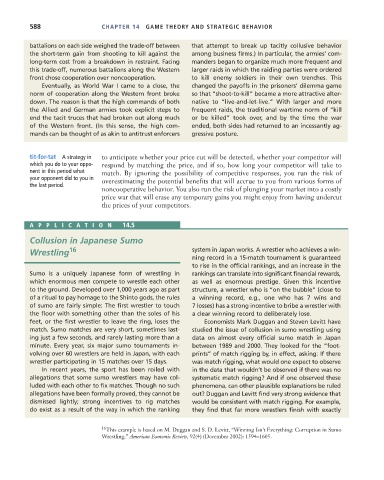Page 614 - Microeconomics, Fourth Edition
P. 614
c14gametheoryandstrategicbehavior.qxd 8/6/10 8:22 AM Page 588
588 CHAPTER 14 GAME THEORY AND STRATEGIC BEHAVIOR
battalions on each side weighed the trade-off between that attempt to break up tacitly collusive behavior
the short-term gain from shooting to kill against the among business firms.) In particular, the armies’ com-
long-term cost from a breakdown in restraint. Facing manders began to organize much more frequent and
this trade-off, numerous battalions along the Western larger raids in which the raiding parties were ordered
front chose cooperation over noncooperation. to kill enemy soldiers in their own trenches. This
Eventually, as World War I came to a close, the changed the payoffs in the prisoners’ dilemma game
norm of cooperation along the Western front broke so that “shoot-to-kill” became a more attractive alter-
down. The reason is that the high commands of both native to “live-and-let-live.” With larger and more
the Allied and German armies took explicit steps to frequent raids, the traditional wartime norm of “kill
end the tacit truces that had broken out along much or be killed” took over, and by the time the war
of the Western front. (In this sense, the high com- ended, both sides had returned to an incessantly ag-
mands can be thought of as akin to antitrust enforcers gressive posture.
tit-for-tat A strategy in to anticipate whether your price cut will be detected, whether your competitor will
which you do to your oppo- respond by matching the price, and if so, how long your competitor will take to
nent in this period what match. By ignoring the possibility of competitive responses, you run the risk of
your opponent did to you in overestimating the potential benefits that will accrue to you from various forms of
the last period.
noncooperative behavior. You also run the risk of plunging your market into a costly
price war that will erase any temporary gains you might enjoy from having undercut
the prices of your competitors.
APPLICA TION 14.5
Collusion in Japanese Sumo
Wrestling 16 system in Japan works. A wrestler who achieves a win-
ning record in a 15-match tournament is guaranteed
to rise in the official rankings, and an increase in the
Sumo is a uniquely Japanese form of wrestling in rankings can translate into significant financial rewards,
which enormous men compete to wrestle each other as well as enormous prestige. Given this incentive
to the ground. Developed over 1,000 years ago as part structure, a wrestler who is “on the bubble” (close to
of a ritual to pay homage to the Shinto gods, the rules a winning record, e.g., one who has 7 wins and
of sumo are fairly simple: The first wrestler to touch 7 losses) has a strong incentive to bribe a wrestler with
the floor with something other than the soles of his a clear winning record to deliberately lose.
feet, or the first wrestler to leave the ring, loses the Economists Mark Duggan and Steven Levitt have
match. Sumo matches are very short, sometimes last- studied the issue of collusion in sumo wrestling using
ing just a few seconds, and rarely lasting more than a data on almost every official sumo match in Japan
minute. Every year, six major sumo tournaments in- between 1989 and 2000. They looked for the “foot-
volving over 60 wrestlers are held in Japan, with each prints” of match rigging by, in effect, asking: If there
wrestler participating in 15 matches over 15 days. was match rigging, what would one expect to observe
In recent years, the sport has been roiled with in the data that wouldn’t be observed if there was no
allegations that some sumo wrestlers may have col- systematic match rigging? And if one observed these
luded with each other to fix matches. Though no such phenomena, can other plausible explanations be ruled
allegations have been formally proved, they cannot be out? Duggan and Levitt find very strong evidence that
dismissed lightly; strong incentives to rig matches would be consistent with match rigging. For example,
do exist as a result of the way in which the ranking they find that far more wrestlers finish with exactly
16 This example is based on M. Duggan and S. D. Levitt, “Winning Isn’t Everything: Corruption in Sumo
Wrestling,” American Economic Review, 92(4) (December 2002): 1594–1605.

